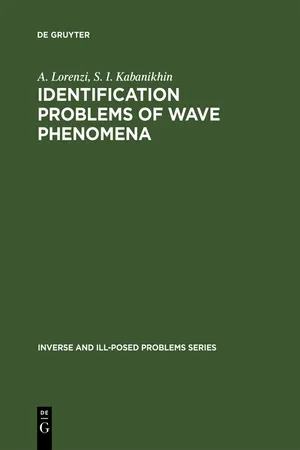
This is a test
- 352 pages
- English
- PDF
- Available on iOS & Android
eBook - PDF
Identification Problems of Wave Phenomena
Book details
Table of contents
Citations
About This Book
The Inverse and Ill-Posed Problems Series is a series of monographs publishing postgraduate level information on inverse and ill-posed problems for an international readership of professional scientists and researchers. The series aims to publish works which involve both theory and applications in, e.g., physics, medicine, geophysics, acoustics, electrodynamics, tomography, and ecology.
Frequently asked questions
At the moment all of our mobile-responsive ePub books are available to download via the app. Most of our PDFs are also available to download and we're working on making the final remaining ones downloadable now. Learn more here.
Both plans give you full access to the library and all of Perlego’s features. The only differences are the price and subscription period: With the annual plan you’ll save around 30% compared to 12 months on the monthly plan.
We are an online textbook subscription service, where you can get access to an entire online library for less than the price of a single book per month. With over 1 million books across 1000+ topics, we’ve got you covered! Learn more here.
Look out for the read-aloud symbol on your next book to see if you can listen to it. The read-aloud tool reads text aloud for you, highlighting the text as it is being read. You can pause it, speed it up and slow it down. Learn more here.
Yes, you can access Identification Problems of Wave Phenomena by A. Lorenzi, S. I. Kabanikhin in PDF and/or ePUB format, as well as other popular books in Mathematics & Differential Equations. We have over one million books available in our catalogue for you to explore.
Information
Table of contents
- Introduction
- Chapter 1. Statements of the direct and inverse problems. Examples
- 1.1. Introduction
- 1.2. Inverse Problems of Mathematical Physics
- 1.3. Inverse problem for the wave equation
- 1.4. The equation of plane waves. The d’Alembert formula
- 1.5. The Cauchy problem
- 1.6. The d’Alembert operator with smooth initial data
- 1.7. The Kirchhoff and Poisson formulae
- 1.8. Huygens principle
- 1.9. Time-like and space-like surfaces
- 1.10. Inverse problems with smooth initial data
- 1.11. Inverse problem for the acoustic equation
- Chapter 2. Volterra operator equations
- 2.1. Main definitions
- 2.2. Local well-posedness
- 2.3. Well-posedness for sufficiently small data
- 2.4. Well-posedness in the neighborhood of the exact solution
- Chapter 3. Inverse problems for Maxwell’s equations
- 3.1. Introduction
- 3.2. Reduction of inverse problem for Maxwell’s equations to a Volterra operator equation
- 3.3. Local well-posedness and global uniqueness
- 3.4. Well-posedness in the neighborhood of the exact solution
- Chapter 4. Linearization and Newton-Kantorovich method
- 4.1. Linearization of Volterra operator equations
- 4.2. he linearized inverse problem for the wave equation
- 4.3. The Newton-Kantorovich method
- Chapter 5. The Gel’fand - Levitan Method
- 5.1. Introduction
- 5.2. Gel’fand-Levitan’s approach to multidimensional inverse problems
- 5.3. Discrete inverse problems
- 5.4. Discrete direct problems
- 5.5. An auxiliary problem
- 5.6. A necessary condition for the existence of the global solution to the discrete inverse problem
- 5.7. Sufficient conditions for the existence of the global solution to the discrete inverse problem
- Chapter 6. Regularization
- 6.1. Introduction
- 6.2. Volterra regularization
- Chapter 7. The method of the optimal control
- 7.1. Introduction
- 7.2. Discrete inverse problem
- 7.3. Special representation for the solution to the discrete direct problem
- 7.4. Uniqueness of the stationary point
- Chapter 8. Inversion of finite-difference schemes
- 8.1. Convergence of the method of inversion of finite-difference schemes
- 8.2. Picard and Caratheodory successive approximations
- Chapter 9. Strongly ill-posed problems
- 9.1. A strongly ill-posed problem for the Laplace equation
- 9.2. Conditional continuous dependence on the data
- 9.3. Approximate solutions to the Cauchy problem for the Laplace equation
- 9.4. Approximate solutions to the non-characteristic problem for the multidimensional heat equation
- 9.5. Existence of solutions satisfying operator inequalities
- Chapter 10. Identification problems related to first-order scalar semilinear equations
- 10.1. The scalar inverse problem
- Chapter 11. An identification problem for a first-order integro- differential equation
- 11.1. Introduction
- 11.2. The identification problem and its equivalence to a system of integral equations
- 11.3. Existence and uniqueness
- 11.4. Proof of Lemma 11.2.1
- Chapter 12. An inverse hyperbolic integro-differential problem arising in Geophysics
- 12.1. Introduction and statement of the main result
- 12.2. The transformed inverse problem
- 12.3. Equivalence of problem (12.2.18)—(12.2.22) with a fixed-point system
- 12.4. Solving the fixed-point system (12.3.9)—(12.3.12)
- 12.5. Estimating the solution (z,p,q) to problem (12.3.9)—(12.3.12)
- 12.6. Proof of Theorem 12.1.1
- Chapter 13. Integro-differential identification problems related to the one-dimensional wave equation
- 13.1. Introduction
- 13.2. Statement of the identification problem
- 13.3. The existence and uniqueness theorem
- Chapter 14. Lavrent’ev regularization of solutions to linear integro-differential inverse problems
- 14.1. Introduction
- 14.2. Well-posedness of the linear inverse problem when g Є C3([0, T])
- 14.3. A convergence theorem
- 14.4. An algorithm for a numerical solution
- 14.5. Basic properties of the cost function and its gradient
- Chapter 15. A stability result for the identification of a nonlinear term in a semilinear hyperbolic integro-differential equation
- 15.1. Introduction
- 15.2. Statements of the main results
- 15.3. Proof of Theorem 15.2.1
- 15.4. Statement of the stability result
- 15.5. Proof of Theorem 15.4.1
- Chapter 16. Inverse problems in Electromagnetoelasticity
- 16.1. Formulation of the direct and inverse problems
- 16.2. The optimization method for solving the inverse problem
- 16.3. The finite-difference schemes
- Bibliography